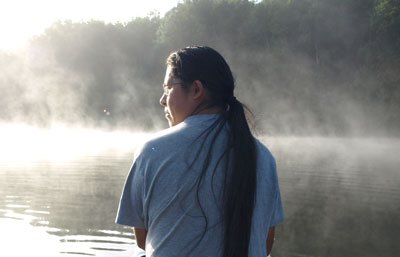By Xavier Kataquapit
(www.underthenorthernsky.com) – Koon is the Cree word for snow. It is a natural phenomenon that covers our northern world every winter and it is a very important part of life on the James Bay coast.
As a boy growing up in the north, snow was just a normal part of life and we never had any fear about it or gave much thought about the dangers of the cold. Susan, my mom, was always careful to bundle us up in warm clothes and a new set of her moose hide mitts, a fur lined hat or a hand knit toque and plenty of layers of shirts, pants and long underwear. We thought nothing of wandering out into blinding snowstorms to make it to school. It was normal for us to head out into minus 30 and minus 40 degree or colder weather to make our trek to school after the holidays.
As children we found mounds of snow and snow drifts were great places to play in. After big storms, snow drifts could build up as high as the eaves of buildings. Every winter storm changed our play areas from packed snow to new forms of drifts and mounds that covered everything in pristine new layers of white.
No matter how freezing the weather was, on cold winter days we would head out to find our friends and play. As young boys, we took our hand made miniature wooden sleds which we pulled by strings on a stick to mimic our parents and other hunters and their big snow machines. We would head out into blowing cold snow storms and blizzards pretending that we were braving the deadly cold hundreds of miles from home and surviving on our own. Of course at one point reality set in and our bravery finally gave way to frozen feet, hands and ears and we ran home to warm up with a hot cup of tea, bannock and the warmth of a wood stove fire.
I never shovelled much snow at home when I was a boy. We only ever shovelled the front step to unblock the entrance and that was about it. Instead, we trampled down the snow and walked over it layer by layer. Usually by mid winter, our front staircase would lose a step or two as the packed snow grew thicker.
I spent my first few years of high school in Timmins when I was a teenager and I lived with a host family during the school months. There were many things that were new to me at the time. The winter culture was very different than what I was accustomed to in my northern home in Attawapiskat. I was surprised that people spent so much time in Timmins shovelling and moving snow to uncover and clear their driveways and walk ways. Everyone avoided walking in the snow and I remember feeling that it was unusual because I had spent all my childhood playing in snow and paths and roadways were more or less full of snow back home.
Snow is important to everyone in the far north. This white layer of fluff and ice unlocks the world to us in our mushkeg wilderness. In the summer, the land is swampy and impassable but once it freezes over, we are able to travel anywhere and everywhere. In the old days about 60 years ago most of my people, the Cree of James Bay travelled by dog sled or snowshoes. People would spend weeks and months moving on the land to hunt, fish and trap. In the 1960s and 70s the snowmobile arrived and suddenly we had the power to move about on the land and cover vast distances.
These days we have a much more sophisticated ice road system that links the communities together on the coast and that allows us to visit back and forth. Before the current pandemic we even had an ice road that took us to the south and places like Kapuskasing, Cochrane, Timmins and the highway system beyond. Many of my family members and friends purchased trucks and cars over the past 20 years to take advantage of travel on the winter ice road. Today the ice road is still being developed but the link to southern towns and cities is not open this year due to the Covid19 pandemic.
It is sad that finally when we have the opportunity to easily travel from community to community and points south that we are faced with spreading this new Covid19 Omicron variant and making many people sick. We are all looking forward to better management of this virus with the hope that enough people are vaccinated and the virus begins to wane. Perhaps then we can get back on the ice roads again in a big way.
For more information visit www.underthenorthernsky.com @XKataquapit – Twitter



Be the first to comment on "Xavier Kataquapit: Staying safe in the cold"